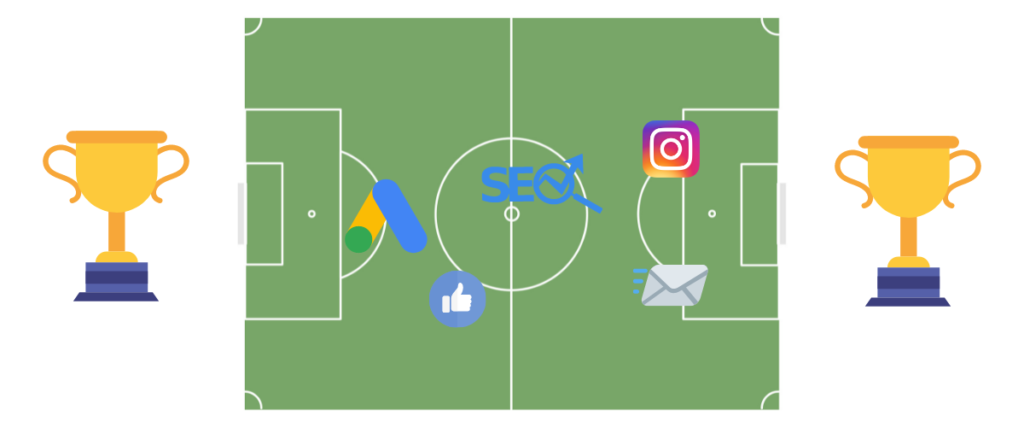
Why organic traffic is the real team player for your website
Every sports team has different roles and positions, that work together to get the win. Often the attacking positions such as strikers and forwards get the most attention: they’re in the thick of the action and responsible for scoring the points needed for the win. Then the defence, lowkey in the back, but the last stand between victory and defeat.
And then you have the ones in the middle. Not always noticeable, jumping in where needed, they’re definitely part of the team. However, they’re usually not your first choice for a position or the first thing you think of when thinking of your favourite sport. But can the team play without them?
You probably didn’t need more than the title to know this analogy was coming, but I’m going to continue it anyway: let’s have a look at the different roles different traffic channels play, and how it’s teamwork that makes the dream work (yes, I went there).
Website traffic as a sports team
PPC, Social Ads, Google Shopping. Flashy, strong, and in your face, these are definitely the forwards of the digital acquisition team. They may be a bit pricey, but they have better access to be in the right place at the right time. Through (re)targeting and platform insights, these are the channels that are great at scoring goals – the evidence is probably shown in the conversion rate you see on your own site.
 In defence, we have e-mail marketing, organic social, and true direct traffic. Acquiring a customer is one thing – retaining them is a whole new level. Owned channels like e-mail are often a great opportunity to build a relationship with those who have already shown interest. While our forwards connect on a more public level, the defence is invited to a more private space. A privilege with great responsibility, as a faux-pas here can severely damage the relationship.
In defence, we have e-mail marketing, organic social, and true direct traffic. Acquiring a customer is one thing – retaining them is a whole new level. Owned channels like e-mail are often a great opportunity to build a relationship with those who have already shown interest. While our forwards connect on a more public level, the defence is invited to a more private space. A privilege with great responsibility, as a faux-pas here can severely damage the relationship.
Then last, but what I am aiming at, definitely not least, organic traffic. As midfielders of the team, organic traffic does a little bit of everything, and like a true midfielder, without organic traffic, the other channels don’t perform quite as well. Yet many businesses don’t invest in SEO to improve organic traffic or underestimate the role it plays for the acquisition team. Let’s dive in a little deeper.
Organic traffic: the real MVP
 Acquiring traffic to your website is a big deal. Without doing this, you can’t lead them further down the funnel to eventually become a customer of your business. With that goal in mind, it is often metrics such as conversion rate and goal completion rate that get the most attention, and in most cases, it is our forwards and defenders that perform best in this area.
Acquiring traffic to your website is a big deal. Without doing this, you can’t lead them further down the funnel to eventually become a customer of your business. With that goal in mind, it is often metrics such as conversion rate and goal completion rate that get the most attention, and in most cases, it is our forwards and defenders that perform best in this area.
But that doesn’t mean organic didn’t play its part.
In my experience in a strong channel mix, organic traffic is strong, but the conversion rate is lower than in owned channels and paid channels. If we only look at face value, judging by conversion rate, it is not as profitable a channel. This couldn’t be further from the truth, and it misses the point of the midfielder.
Conversion rates are often based on a last-click model: the channel that was the last driver gets the point. But how many touchpoints did it take to convert your new customer? A common marketing knowledge nugget is it takes 5 impressions for your brand or ad to stick. Some say 3, some go as high as 10. Nobody ever says it’s the one moment that converts.
So who passed the ball to the forward?
Organic traffic is often the highest traffic-driving channel. Though not always resulting in conversion, it’s a channel used more in the research and awareness stages of the sales funnel. At this point, the user isn’t ready yet to make a decision, but positive interactions such as a good user experience and great content will help persuade them when they’re ready.
So when they next search, they will click the first available link, probably a paid ad. Or when they next see your ads on social, they remember they had an interest in your brand. As a team, the visitor gets converted to a customer.
SEO: the trainer, coach, and physical therapist of organic traffic
 Having the different positions in your team filled is one thing – having them perform is another. Any ad-based efforts need a budget, data, and someone to utilise them correctly and efficiently. Your owned channels need their own retention specialists to keep connecting with your customer base, on their terms.
Having the different positions in your team filled is one thing – having them perform is another. Any ad-based efforts need a budget, data, and someone to utilise them correctly and efficiently. Your owned channels need their own retention specialists to keep connecting with your customer base, on their terms.
Most companies have no problem assigning budget and efforts to these channels, as the conversion and revenue metrics so clearly indicate they are worth it.
But what happens if you only pay your forwards and defenders? You only train on penalties, and forget about endurance training? Is your team still as effective? Most likely they get into trouble real fast. Without midfielders, both offence and defence need to work a lot harder to get the same result. Not only does this impact budget, but they may also need to cover areas they just aren’t the best suited for, impacting overall efficiency.
So you’ve taken on a midfielder, but don’t give them the training and coaching needed, or help them recover after an injury. Are they still going to perform their role correctly? The answer is no: this will always stop your team from reaching its full potential. There is no way you move up a league if you only invest in some of your team.
So if you have a budget for retention and a budget for ads, you need to add a budget for SEO if you want all channels to perform as efficiently as possible. It is the only way to get the most out of your organic traffic, tackle the awareness and research stages effectively, and provide these passes to the forward channels to score the goal.
Have your channels work as a true acquisition team
Scoring goals, winning games, moving up a league. It can’t be done without hard work, effort, and investment from the entire team, and the resources to allow the team to do so. Whether that’s more budget for your ads, or a search optimisation specialist for organic, without input in all areas your team will not perform to its best abilities.
So ask yourself: are you currently supporting all your channels? And if not, what’s holding you back?
